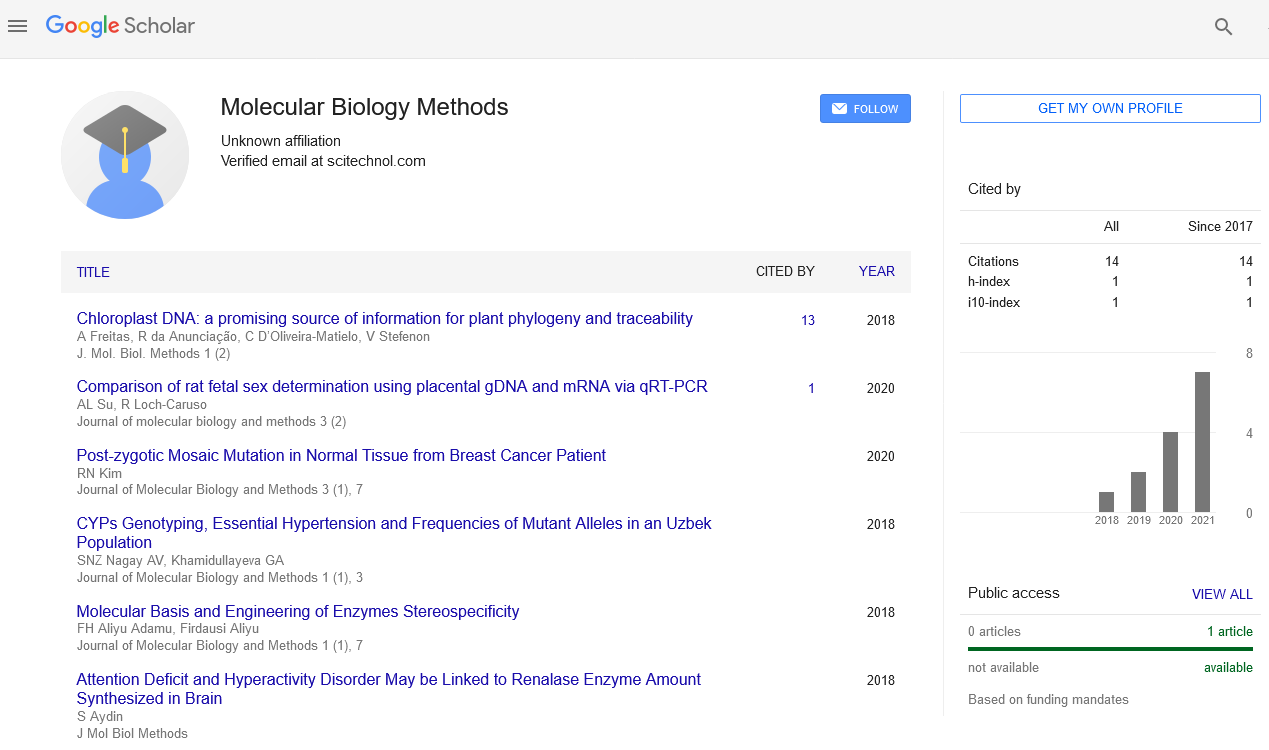Perspective, J Mol Biol Methods Vol: 4 Issue: 4
Neuroscience is the Logical Investigation of the Anxious System
Roskmas Jane*
Department of Developmental neuroscience, The University of Brotish Columbia, Vancouver, Canada
*Corresponding author: Roskmas Jane, Department of Developmental neuroscience, The University of British Columbia, Vancouver, Canada, E-mail: jane.roskmas@ubc.edu
Received date: July 08, 2021; Accepted date: July 23, 2021; Published date: July 30, 2021
Keywords: Apoptosis, Biochemistry, Bioinformatics
Introduction
Neuroscience is the logical investigation of the anxious system. It is a multidisciplinary science that joins physiology, life structures, subatomic science, formative science, cytology, software engineering and numerical demonstrating to comprehend the crucial and new properties of neurons and neural circuits. The comprehension of the organic premise of learning, memory, conduct, insight, and cognizance has been depicted by Eric Kindle as "a definitive test" of the natural sciences. The extent of neuroscience has widened over the long run to incorporate various methodologies used to examine the sensory system at various scales and the procedures utilized by neuroscientists have extended colossally, from atomic and cell investigations of individual neurons to imaging of tangible, engine and psychological undertakings in the cerebrum. The most punctual investigation of the sensory system dates to antiquated Egypt. Trepanation, the careful act of one or the other boring or scratching an opening into the skull to fix head wounds or mental issues, or diminishing cranial pressing factor, was first recorded during the Neolithic time frame. Original copies dating to 1700 BC demonstrate that the Egyptians had some information about indications of cerebrum damage. Early perspectives on the capacity of the mind respected it to be a "cranial stuffing" of sorts. In Egypt, from the late Middle Kingdom onwards, the mind was routinely taken out in anticipation of embalmment. It was accepted at the time that the heart was the seat of insight. As per Herodotus, the initial step of preservation was to "take a warped piece of iron, and with it draw out the mind through the nostrils, in this way disposing of a bit, while the skull is gotten free from the rest by flushing with drugs. “The view that the heart was the wellspring of awareness was not tested until the hour of the Greek doctor Hippocrates. He accepted that the mind was not just associated with sensation—since most particular organs e.g., eyes, ears, tongue are situated in the head close to the cerebrum—but at the same time was the seat of intelligence. Plato likewise guessed that the mind was the seat of the sane piece of the soul. Aristotle, in any case, accepted the heart was the focal point of knowledge and that the cerebrum managed the measure of warmth from the heart. This view was by and large acknowledged until the Roman doctor Galen, an adherent of Hippocrates and doctor to Roman combatants, seen that his patients lost their intellectual capacities when they had supported harm to their brains. Abulcasis, Averroes, Avicenna, Avenzoar, and Maimonides, dynamic in the Medieval Muslim world, depicted various clinical issues identified with the cerebrum. In Renaissance Europe, Vesalius, René Descartes, Thomas Willis and Jan Swammerdam likewise made a few commitments to neuroscience. Luigi Galvani's spearheading work in the last part of the 1700s set up for examining the electrical edginess of muscles and neurons. In the main portion of the nineteenth century, Jean Pierre Florins spearheaded the trial strategy for doing confined sores of the cerebrum in living creatures portraying their consequences for motricity, reasonableness and conduct. In 1843 Emil du Bois-Raymond showed the electrical idea of the nerve signal, whose speed Hermann von Helmholtz continued to measure, and in 1875 Richard Caton discovered electrical marvels in the cerebral halves of the globe of bunnies and monkeys. Adolf Beck distributed in 1890 comparative perceptions of unconstrained electrical action of the cerebrum of hares and dogs. Studies of the mind turned out to be more complex get-togethers creation of the magnifying lens and the advancement of a staining method by Camilla Golgi during the last part of the 1890s. The methodology utilized a silver chromate salt to uncover the mind boggling constructions of individual neurons. His method was utilized by Santiago Ramón y Canal and prompted the arrangement of the neuron teaching, the theory that the utilitarian unit of the cerebrum is the neuron. Golgi and Ramón y Canal shared the Nobel Prize in Physiology or Medicine in 1906 for their broad perceptions, depictions, and orders of neurons all through the mind. In corresponding with this exploration, work with cerebrum harmed patients by Paul Boca recommended that specific areas of the mind were liable for specific capacities. At that point, Boca’s discoveries were viewed as an affirmation of Franz Joseph Gall's hypothesis that language was restricted and that specific mental capacities were limited in explicit spaces of the cerebral cortex. The confinement of capacity theory was upheld by perceptions of epileptic patients led by John Hugh lings Jackson, who accurately deduced the association of the engine cortex by watching the movement of seizures through the body. Carl Wernicke further fostered the hypothesis of the specialization of explicit mind structures in language cognizance and creation. Current exploration through neuroimaging methods, actually utilizes the Bradman cerebral cytoarchitectonic guide alluding to investigation of cell structure anatomical definitions from this time in proceeding to show that particular spaces of the cortex are enacted in the execution of explicit tasks.
 Spanish
Spanish  Chinese
Chinese  Russian
Russian  German
German  French
French  Japanese
Japanese  Portuguese
Portuguese  Hindi
Hindi 